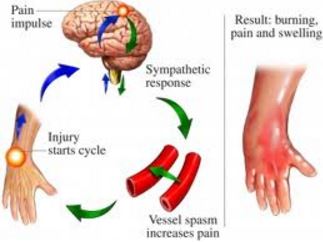Causalgia
Causalgia Definition
Causalgia is an atypical pain syndrome affected mostly in upper and lower limbs. This condition is preceded mostly after injury which mainly affects peripheral nerves and leads to histological changes on the particular part of the body. Ultimately blood circulation of that part is hindered. The intensity of the pain is varied and depending upon this, causalgia may be mild or severe.
Pathogenesis
The causalgia development has two mechanisms.
The early pain syndrome is associated with peripheral nerve injury. This leads to stimulation of the postganglionic effectors and peripheral nerve endings. Often this causes vascular, especially arteriolar contraction. This contraction is continued due to release of neurotransmitter, epinephrine.
The tissues do not obtain sufficient amount of oxygen supply which leads to anoxia. This effect mainly occurs in the cutaneous tissue of the affected area, which leads to different skin texture changes like shiny, scaly, dry skin or excessive moist skin with patchy brown discoloration due to neurological injury.

Symptoms
Mild causalgia is quite similar with reflex sympathetic dystrophy.
- After 24 hours of the injury, the burning sensation like pain is felt. The intensity of the pain increase with sensory stimulation which include touching also.
- Vasodialation or vasoconstriction occurs, which increases or decreases blood circulation.
- Body temperature increases or decreases.
- Dry and scaly skin texture is prominent
- Affected joint becomes stiffen
- Shape of the figures become narrow
- Nails shape is uneven
- Hair become brittle which leads to hair lose
- Perspiration rate is altered
Causes
The exact cause of development of causalgia is not known. More than one factor which mainly involve to stimulation of the sympathetic nervous system and leads to over activity of the peripheral neurological effects are causes causalgia. Inflammatory mediators release may also have role to promoting the condition.
The scientific evidence predicted that peripheral nerve injury leads to impair the vasomotor control at the affected part of the limbs and produce severe pain at the site. Intense pain prolongs the neurological sensitization of the arteriolar smooth muscle. This leads to increase the plasma of epinephrine amount than the normally. Untreated condition causes tissue anoxia which produce irreversible histological changes in the affected part.
Triggering factors
The following triggering factors increase the probability of onset of causalgia:
- Accidental Trauma
- Bone fracture
- Immobilization of the limb
- Delayed healing process than the usual time
- Drug induced condition which includes Angiotensin Converting Enzymes Inhibitors (ACEI).
Diagnosis
Initial diagnosis is started with discussion of medical history with sign and symptoms discussion which is followed by physical examination. Usually the conduction of physical examination is tough, as patient is complaining about pain due to touching.
The following imaginary tests are conducted
- X-ray
- Bone Scan
- CT scan
- MRI
- The checking of electrical impulses need to check like
- Nerve conduction examination
- Electromyography
- By using a thermogram, heat generation in the body is checked.
- The evaluation of autonomic nervous system is also conducted either by using quantitative sudomotor axon reflex test (QSART), resting sweat output (RSO), or the resting skin temperature (RST).
Treatment
Early diagnosis and initiation of treatment can restrict the continuous degenerative condition of the affected tissues. The following treatment is mainly recommended for the treatment of the causalgia.
- Blocking of the sympathetic nerve chain at the lumber region at L2, L3 and L4 by using the medications like intracaine or procaine are provide effective treatment for lower limbs.
- Permanent blockage can be done by using alcohol at the 60% to 90% concentration. The blocking of nerve depends upon the technique and skill used for this purpose rather than the drug concentration.
- For the upper limbs, the blocking or detachment of the 2nd and 3rd thoracic ganglia with interval of the sympathetic chain between the 3rd and 4th ganglia is measured by a practicable method of healing which does not create the associated disability of Horner’s Syndrome.
- Surgical intervention for blocking the affected nerve signaling or complete removal of the affected sympathetic nerve (sympathectomy) is more effective for most of the cases. The included techniques for this surgical interventions are thoracic endoscopy, anterior thoracic, supraclavicular and percutaneous radiofrequency. In this process the significant associated risk is not more than 5%. The included risks are spinal cord injury, lungs becoming collapsed, ribs area generating pain and also Horner’s syndrome.
References
- http://neurosurgery.ucla.edu/body.cfm?id=1123&ref=18&action=detail
- http://www.medicinenet.com/script/main/art.asp?articlekey=25013
- (CRPS; Reflex Sympathetic Dystrophy [RSD]; Causalgia; Sympathetically Maintained Pain) at https://www.mountsinai.org/patient-care/health-library/diseases-and-conditions/causalgia
- http://www.ncbi.nlm.nih.gov/pmc/articles/PMC1521551/
